QF 1-pounder pom-pom
The QF 1 pounder, universally known as the pom-pom due to the sound of its discharge,[4][5][6] was a 37 mm British autocannon, the first of its type in the world. It was used by several countries initially as an infantry gun and later as a light anti-aircraft gun.
| QF 1 pdr Mark I & II ("pom-pom") | |
|---|---|
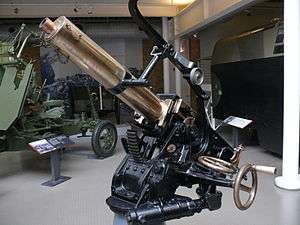 Mk II gun dated 1903, on anti-aircraft mounting, at the Imperial War Museum, London.[1] | |
| Type | Autocannon |
| Place of origin | |
| Service history | |
| In service | 1890s–1918 |
| Used by | South African Republic British Empire German Empire Belgium United States |
| Wars | Spanish–American War Second Boer War World War I |
| Production history | |
| Designer | Hiram Maxim |
| Designed | Late 1880s |
| Manufacturer | Maxim-Nordenfelt Vickers, Sons & Maxim DWM |
| Variants | Mk I, Mk II |
| Specifications | |
| Mass | 410 pounds (186.0 kg) (gun & breech) |
| Length | 6 ft 1 in (1.85 m) (total) |
| Barrel length | 3 ft 7 in (1.09 m) (bore) L/29 |
| Shell | 37 x 94R. 1 lb (0.45 kg) Common Shell |
| Calibre | 37-millimetre (1.457 in) |
| Barrels | 1 |
| Action | automatic, recoil |
| Rate of fire | ~300 rpm (cyclic) |
| Muzzle velocity | 1,800 ft/s (550 m/s)[2] |
| Maximum firing range | 4,500 yards (4,110 m) (Mk I+ on field carriage)[3] |
| Filling weight | 270 grains (17 g) black powder |
History
Hiram Maxim originally designed the Pom-Pom in the late 1880s as an enlarged version of the Maxim machine gun. Its longer range necessitated exploding projectiles to judge range, which in turn dictated a shell weight of at least 400 grams (0.88 lb), as that was the lightest exploding shell allowed under the St. Petersburg Declaration of 1868 and reaffirmed in the Hague Convention of 1899.[7]
Early versions were sold under the Maxim-Nordenfelt label, whereas versions in British service (i.e. from 1900) were labelled Vickers, Sons and Maxim (VSM) as Vickers had bought out Maxim-Nordenfelt in 1897 but they are the same gun.
Service by nation
Belgium
The Belgian Army used the gun on a high-angle field carriage mounting.[3]
Germany
A version was produced in Germany for both Navy and Army.[3]
In World War I, it was used in Europe as an anti-aircraft gun as the Maxim Flak M14. Four guns were used mounted on field carriages in the German South West Africa campaign in 1915, against South African forces.[8]
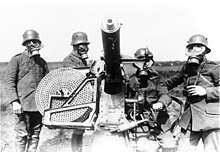 German gunners wearing gasmasks, with Maxim Flak M14
German gunners wearing gasmasks, with Maxim Flak M14
United Kingdom
Second Boer War
The British government initially rejected the gun but other countries bought it, including the South African Republic (Transvaal) government. In the Second Boer War, the British found themselves being fired on by the Boers with their 37 mm Maxim-Nordenfelt versions using ammunition made in Germany. The Boers' Maxim was also a large caliber, belt-fed, water-cooled machine gun that fired explosive rounds (smokeless ammunition) at 450 rounds per minute.[9]
Vickers-Maxim shipped either 57 or 50 guns out to the British Army in South Africa, with the first three arriving in time for the Battle of Paardeberg of February 1900.[10][11] These Mk I versions were mounted on typical field gun type carriages.
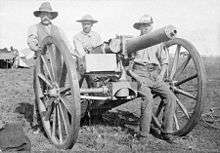 Australian troopers with a captured 1-pounder in South Africa circa. 1901
Australian troopers with a captured 1-pounder in South Africa circa. 1901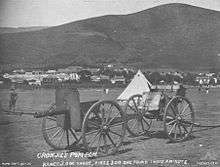 Boer 1-pounder with shield
Boer 1-pounder with shield
World War I
In World War I, it was used as an early anti-aircraft gun in the home defence of Britain. It was adapted as the Mk I*** and Mk II on high-angle pedestal mountings and deployed along London docks and on rooftops on key buildings in London, others on mobile motor lorries at key towns in the East and Southeast of England. 25 were employed in August 1914, and 50 in February 1916.[12] A Mk II gun (now in the Imperial War Museum, London) on a Naval pedestal mounting was the first to open fire in defence of London during the war.[3] However, the shell was too small to damage the German Zeppelin airships sufficiently to bring them down.[13] The Ministry of Munitions noted in 1922: "The pom-poms were of very little value. There was no shrapnel available for them, and the shell provided for them would not burst on aeroplane fabric but fell back to earth as solid projectiles ... were of no use except at a much lower elevation than a Zeppelin attacking London was likely to keep".[14]
Lieutenant O. F. J. Hogg of No. 2 AA Section in III Corps was the first anti-aircraft gunner to shoot down an aircraft, with 75 rounds on 23 September 1914 in France.[15] The British Army did not employ it as an infantry weapon in World War I, as its shell was considered too small for use against any objects or fortifications and British doctrine relied on shrapnel fired by QF 13 pounder and 18-pounder field guns as its primary medium range anti-personnel weapon. The gun was experimentally mounted on aircraft as the lighter 1-pounder Mk III, the cancelled Vickers E.F.B.7 having been designed to carry it in its nose.[16] As a light anti-aircraft gun, it was quickly replaced by the larger QF 1½ pounder and QF 2 pounder naval guns.
British ammunition
The British are reported to have initially used some Common pointed shells (semi-armour piercing, with fuse in the shell base) in the Boer War, in addition to the standard Common shell. The common pointed shell proved unsatisfactory, with the base fuse frequently working loose and falling out during flight.[11][17] In 1914, the cast-iron common shell and tracer were the only available rounds.[18]
 Mk I Steel shell, 1902
Mk I Steel shell, 1902 Mk II explosive Common shell & Mk I tracer round, 1914
Mk II explosive Common shell & Mk I tracer round, 1914
United States
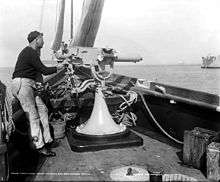
The U.S. Navy adopted the Maxim-Nordenfelt 37 mm 1-pounder as the 1-pounder Mark 6 before the 1898 Spanish–American War. The Mark 7, 9, 14, and 15 weapons were similar. It was the first dedicated anti-aircraft (AA) gun adopted by the US Navy, specified as such on the Sampson-class destroyers launched in 1916-17. It was deployed on various types of ships during the US participation in World War I, although it was replaced as the standard AA gun on new destroyers by the 3 inch (76 mm)/23 caliber gun.
Previously, with the advent of the steel-hulled "New Navy" in 1884, some ships were equipped with the 1-pounder Hotchkiss revolving cannon.
In the aftermath of the Battle of Blair Mountain, the United States Army deployed artillery, including pompoms: "Their armament was strengthened with a howitzer and two pompoms."[20]
Rapid-firing (single shot, similar to non-automatic QF guns) 1-pounders were also used, including the Sponsell gun and eight other marks; the Mark 10 to be mounted on aircraft. Designs included Hotchkiss and Driggs-Schroeder. A semi-automatic weapon and a line throwing version were also adopted. Semi-automatic in this case meant a weapon in which the breech was opened and cartridge ejected automatically after firing, ready for manual loading of the next round.
It is often difficult to determine from references whether "1-pounder RF" refers to single-shot, revolving cannon, or Maxim-Nordenfelt weapons.
Surviving examples

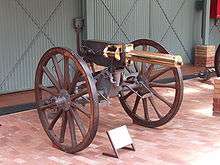
- A gun from 1903 at the Imperial War Museum London.[1]
- Two German-manufactured 1903 guns used during World War I are on display at the South African National Museum of Military History, Johannesburg. Nr. 542 and 543 from the Deutsche Waffen- und Munitionsfabriken.
- A German-manufactured gun in the Wehrtechnische Studiensammlung Koblenz, Germany.[21]
- A gun in Bridgton, Maine.
- An early Maxim-Nordenfelt gun, no. 2024, is currently on display the American Heritage Museum in Stow, Massachusetts.
- A gun in the Canadian War Museum.
- A gun in the Museo Naval y Maritimo Valparaiso, Chile.[22]
- A gun at the War Museum in Newport News, Va still on field mount. Flak M14
- A gun at the Royal Danish Arsenal Museum in Copenhagen, Denmark.
See also
- COW 37 mm gun
- List of anti-aircraft guns
- List of infantry guns
Notes and references
- Imperial War Museum (2012). "1 pdr Vickers Gun Mk II". Imperial War Museum Collections Search. Retrieved 18 February 2012.
- "Handbook of the 1-PR. Q.F. Gun", 1902. Page 19, Range Table for British Mk I gun. Muzzle Velocity of 1,800 ft/second, firing 1-pound projectile with 1 oz 90 grains Cordite.
- Hogg & Thurston 1972, pp. 22–23
- The Waverley pictorial dictionary (Volume SIX). London: Waverley Book Co. p. 3335.
- "Weapons". Australian Boer War Memorial Committee. Archived from the original on 19 July 2008. Retrieved 28 August 2008.
- "...my paper strength will be 2,400 mounted men, 6 guns, and 8 pom-poms". Brigadier Henry Rawlinson, 2 January 1902, in South Africa. From "The Life of General Lord Rawlinson of Trent", by Sir Frederick Maurice. London: Cassell, 1928
- Hogg & Thurston 1972, p. 22, state the Hague Convention dictated the 1 lb (0.45 kg) shell; however 400 grams was set as the minimum for exploding shells by Laws of War: Declaration of St. Petersburg; 29 November 1868
- Major D.D. Hall, The South African Military History Society Military History Journal - Vol 3 No 2, December 1974. "GERMAN GUNS OF WORLD WAR I IN SOUTH AFRICA". Major Hall states that these guns were made by Krupp, but the 2 captured guns in the South African Military History Museum were made by Deutsche Waffen und Munitionsfabriken (DWM)
- http://www.smallarmsreview.com/display.article.cfm?idarticles=2490, SOUTH AFRICA’S NATIONAL MUSEUM OF MILITARY HISTORY
- 'The Times History of the War in South Africa' mentions 57; Headlam 'The History of the Royal Artillery' only mentions 50.
- Fiona Barbour, The South African Military History Society Military History Journal - Vol 3 No 1 June 1974. Mystery Shell
- Farndale 1988, pp. 362–363
- Routledge 1994, p. 7–8
- Official History of the Ministry of Munitions 1922, Volume X, Part 6, pp. 24–25. Facsimile reprint by Imperial War Museum and Naval & Military Press 2008. ISBN 1-84734-884-X
- Routledge 1994, p. 5
- THE CANNON PIONEERS: The early development and use of aircraft cannon, by Anthony G Williams
- The British 1902 manual listed only the Common Shell as currently produced : "A number of steel shells have been issued, but no more will be provided": "Handbook of the 1-PR. Q.F. Gun", 1902. Page 18
- Treatise on Ammunition 10th Edition, 1915. War Office, UK
- Lon Savage (1990), Thunder in the Mountains: The West Virginia Mine War, 1920-21, rev. edition, Pittsburgh, PA: University of Pittsburgh, Ch. 24, "'The Miners Have Withdrawn Their Lines'", p.151.
- Bundesamt für Wehrtechnik und Beschaffung
- Museo Naval y Maritimo | Archivo y Biblioteca Histórica de la Armada
Bibliography
- "Handbook of the 1-PR. Q.F. Gun (Mounted on Field Carriage)" War Office, UK, 1902.
- General Sir Martin Farndale, History of the Royal Regiment of Artillery: The Forgotten Fronts and the Home Base, 1914–18. London: Royal Artillery Institution, 1988. ISBN 1-870114-05-1
- I.V. Hogg & L.F. Thurston, British Artillery Weapons & Ammunition 1914–1918. London: Ian Allan, 1972. ISBN 978-0-7110-0381-1
- Brigadier N.W. Routledge, History of the Royal Regiment of Artillery: Anti-Aircraft Artillery, 1914–55. London: Brassey's, 1994. ISBN 1-85753-099-3
External links
| Wikimedia Commons has media related to QF 1 pounder pom-pom. |
- Handbook for the 1-pr. Q. F. gun, mounted on field carriage, 1902 at State Library of Victoria
- Anthony G Williams, 37MM AND 40MM GUNS IN BRITISH SERVICE
- Diagram of 1pr. Q.F. Mark I Land carriage at Victorian Forts and Artillery website
- Diagram of 1pr. Q.F. Mark II Land carriage at Victorian Forts and Artillery website
- DiGiulian, Tony Navweaps.com US Navy 1 pounder